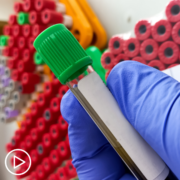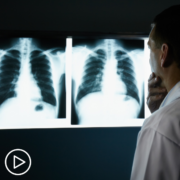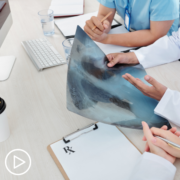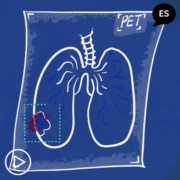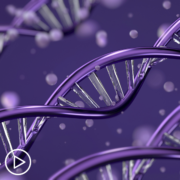LC Access and Affordability Archives
The impact of lung cancer isn’t just physical, it’s also financial. Navigating coverage and out-of-pocket expenses is a minefield for many patients and care partners.
Let us help you make sense of costs, coverage and where to turn to for help.
More resources for Lung Cancer Access and Affordability from Patient Empowerment Network.
Empowering Lung Cancer Patients | Embracing Hope, Treatment, and Teamwork
Empowering Lung Cancer Patients: Embracing Hope, Treatment, and Teamwork from Patient Empowerment Network on Vimeo.
What does the future of non-small cell lung cancer (NSCLC) treatment and care look like? Expert Dr. Samuel Cykert from UNC School of Medicine shares his outlook about the future of care and his advice to patients to help build emotional support.
[ACT]IVATION TIP
“…don’t give up, and one thing I’ve heard from patients over time, particularly among Black patients, there’s a tremendous faith community, and understanding that tremendous faith, faith is excellent, but also use that faith to understand that your belief in God, your interaction with God, God is using those doctors and those healthcare professionals to help you, so it’s not a solo effort, get everybody on the team.”
Download Resource Guide | Descargar guía de recursos
See More from [ACT]IVATED Non-Small Cell Lung Cancer
Related Resources:
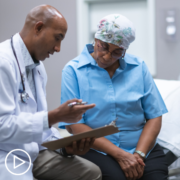
|

Improving Biomarker Testing Access for Rural Lung Cancer Patients |

How Can We Advance Equitable Access to Precision Medicine in Lung Cancer Care? |
Transcript:
Lisa Hatfield:
If you could give one suggestion to patients out there who may not be following up with their appointments, perhaps also in addition to the racial disparities? The unfortunate stigma surrounding lung cancer, and I wonder sometimes if that’s a barrier to continuing treatments or going to appointments, you could give one suggestion or sentence of encouragement to patients to seek out those high volume facilities if they’re diagnosed, if there’s a suspicion of lung cancer and to continue with treatment, what would your message be to those patients?
Dr. Samuel Cykert:
My message to patients, really it’s two-fold. On the medical side, lung cancer deaths are falling, all cancer deaths are falling, and they’re falling because of earlier detection, but they’re also falling because of these new treatments. And so it’s really, really important, particularly if you’re physically able, if you have a good functional status and you’re able to walk around and do things, it’s important that you really, really consider aggressive treatments because lung cancer isn’t an immediate death sentence anymore.
It is true that there are some lung cancers that are not curable, but with some of the new biologic treatments and chemotherapy regimens, people can live years with a good quality of life, even with some advanced lung cancers. So my advice on that side is don’t give up, and one thing I’ve heard from patients over time, particularly among Black patients, there’s a tremendous faith community, and understanding that tremendous faith, faith is excellent, but also use that faith to understand that your belief in God, your interaction with God, God is using those doctors and those healthcare professionals to help you, so it’s not a solo effort, get everybody on the team.
Lisa Hatfield:
Great message. Everybody on the team, I like that. Thank you, Dr. Cykert, and I appreciate all of your answers, and I’m hoping that this message, what people are watching that, understanding those statistics from your research, people who sometimes miss appointments or have transportation issues, maybe this will inspire them to continue finding ways to get there and to keep going, to keep fighting it and getting everybody on their team, I appreciate your message a lot. Thank you.
Share Your Feedback
Create your own user feedback survey
How Can We Advance Equitable Access to Precision Medicine in Lung Cancer Care?
How Can We Advance Equitable Access to Precision Medicine in Lung Cancer Care? from Patient Empowerment Network on Vimeo.
With non-small cell lung cancer (NSCLC) precision medicine, what are disparities and strategies to equitable access? Expert Dr. Samuel Cykert from UNC School of Medicine discusses disparities, strategies to overcome disparities, and proactive patient advice toward optimal care.
[ACT]IVATION TIP
“…I know you do electronic health records, and as soon as this visit is done, you have data about my visit, so have you thought about creating a real-time registry to see how I’m progressing with my care and see how others are progressing with their care, whether to make sure that we don’t have missed appointments and to make sure that I’m not falling behind where I should be.”
Download Resource Guide | Descargar guía de recursos
See More from [ACT]IVATED Non-Small Cell Lung Cancer
Related Resources:

|

Improving Biomarker Testing Access for Rural Lung Cancer Patients |

Empowering Lung Cancer Patients | Embracing Hope, Treatment, and Teamwork |
Transcript:
Lisa Hatfield:
Dr. Cykert, are there any disparities in access to biomarker testing for Black and Latinx patients with lung cancer compared to other racial or ethnic groups, and if so, what strategies or initiatives can be implemented to address these disparities and promote equitable access to precision medicine?
Dr. Samuel Cykert:
Yeah, biomarker testing followed up by precision medicine is really fairly new in the last half-dozen years, so there haven’t been a lot of studies done looking at how well we’re doing in different groups, but there’s a journal called The Journal of Clinical Oncology and precision medicine that published such a study in 2022.
And what that showed…and again, keep in mind that in a lot of…as they do in a lot of database studies, they are a couple of years behind, but what they showed in looking at the cases of over 20,000 patients, is that on first time testing, we talked about initial biopsies, when the initial biopsy is tested, there is actually about a 7 percent difference between Black and white patients with the white number being only 37 percent and the Black number being 30 percent, so that was low all the way around.
And then if you look at any biomolecular testing at any stage of the cancer, those numbers change to around 55 percent for white patients and 44 percent for Black patients, and I want to point out that for Asian patients and Latinx patients, the numbers were also low, but there weren’t enough patients in the database to achieve statistical significance, but it looks like things are going in the wrong direction there too, and when you think about it, in the state of the right now, those numbers ought to be close to 100 percent for everybody, at least in some of the basic markers like ALK and EGFR and PD-L1.
So there’s a lot of work to do. So there is a disparity. It has been documented, but we’re not getting perfect care to even anyone, and in the ACCURE (Accountability for Cancer Care through Undoing Racism and Equity) Study that I had described a little bit earlier, where we did an intervention, we created real-time transparency through up-to-date electronic health records and digital data of where patients were in their care, we were able to create a real-time registry to know what had been done for every patient, and in the case of precision medicine, this would be so easy, because you basically put every patient that’s had a lung cancer biopsy in the registry, then you have another column in the registry tested for X, tested for Y, tested for Z, and then you have a next column that says, treated for X, treated for Y, and treated for Z. We have the digital information now to do all this in real time, and we have to build the systems to do it.
Lisa Hatfield:
Could you share any examples of successful initiatives or programs aimed at improving the implementation of biomarker testing in lung cancer and what factors contribute to the success of these initiatives, and how can they be replicated or scaled in other healthcare settings?
Dr. Samuel Cykert:
I’ll have to plead my ignorance on this question because I haven’t talked to enough cancer centers on whether or not they’re creating real-time registries for whether all their patients with probable lung cancer are, [a] getting biopsied promptly, [b] getting biomarker testing, and then following those patients over time to see if they’re getting the treatments to match to that, so I know that at my own institution at the University of North Carolina Lineberger Cancer Center, we’re actively talking about building these systems, but we haven’t built them yet.
And so going back to the work that our UNC team has done in partnership with Greensboro Health Disparities Collaborative, we’ve done an intervention with real-time transparency in lung cancer treatment and breast cancer treatment, and real-time quality improvement and audit and feedback for accountability in those treatments and using navigation, particularly for high risk patients to make sure that they’re able to follow through with their diagnosis and treatment.
So with that combination in lung cancer, we got almost perfect care, 96 percent and 95 percent completing treatment, so there’s no reason that the same system cannot be applied to biomarker testing and biologic and immunotherapy, and we need to look at it and implement it and apply it as soon as possible, because when you think about all this, and I’m not just talking about cancer, but when you’re thinking about the whole picture, when you look at, for instance, Black, white disparities, whether it’s in cardiovascular care, whether it’s in diabetes, whether it’s in cancer care, if you look at the result of that in one year, if we brought up care to benchmark levels of the Black community on all those things, we would save 74,000 lives a year.
That’s incredibly impactful. And we need to quicken up the pace of doing this. I’ve been a disparities researcher and intervention researcher for over 20 years, and people really haven’t taken note of really doing interventions until the last five or six years. We need to pay attention, we need to move. It’s important. People’s lives depend on it. And care improved for everyone with these systems, it improved for white patients too. It’s not a zero-sum game.
Lisa Hatfield:
I’m wondering, as a patient, is there anything that I can do or that a patient can do to request or to ask if they use real-time data, that institution to help with the treatment or help with testing or whatever, is there a question the patient might be able to ask to ensure the real-time data is used? Because I imagine it’s not being used as often, so it could be, like you said, there probably isn’t a system in place.
Dr. Samuel Cykert:
Here’s my double activation tip. So at an institution, you don’t know if you have a problem until you look. So the first problem is, as I go back and look behind, am I making sure whether or not I’m seeing disparities, whether it’s a man, woman, Black, white, Latinx, do we have disparities in our treatment application and treatment outcomes in our institution? Because if we look at that, we can start brainstorming on how to possibly fix it, and then the second thing is, I know you do electronic health records, and as soon as this visit is done, you have data about my visit, so have you thought about creating a real-time registry to see how I’m progressing with my care and see how others are progressing with their care, whether to make sure that we don’t have missed appointments and to make sure that I’m not falling behind where I should be.
Lisa Hatfield:
Great, that’s perfect, thank you. Having the patients be…have that accountability too, to ask the question, if that exists, that real-time data, if there’s a way to use that. So thank you, I appreciate that myself personally, so thanks.
Share Your Feedback
Create your own user feedback survey
What Urgent Innovations Can Advance Lung Cancer Precision Medicine?
What Urgent Innovations Can Advance Lung Cancer Precision Medicine? from Patient Empowerment Network on Vimeo.
How can non-small cell lung cancer (NSCLC) precision medicine be advanced through urgent innovations? Expert Dr. Samuel Cykert from UNC School of Medicine discusses technology and research innovations and epigenetics.
Download Resource Guide | Descargar guía de recursos
See More from [ACT]IVATED Non-Small Cell Lung Cancer
Related Resources:

|

Improving Biomarker Testing Access for Rural Lung Cancer Patients |

Empowering Lung Cancer Patients | Embracing Hope, Treatment, and Teamwork |
Transcript:
Lisa Hatfield:
In your opinion, what are the most pressing research priorities or areas of innovation needed to further advance the implementation of biomarker testing and precision medicine in the management of lung cancer?
Dr. Samuel Cykert:
Yeah, there are two areas of this, the health services researcher side of me says institutions have to implement systems that follow patients in real time to making sure that they’re getting the testing and treatment that they need from the initial suspicion of lung cancer all the way to biomarker testing and therapies, whether they include surgery, chemo, radiation, biologics or immunotherapy. Those systems need to be areas of priority so that we’re really proactive of not only following patients, but from time to time, whether there are side effects or whether there is confusion, having those systems so we know when to re-engage patients when they’re not progressing along, so on the health services side, we have a lot of just phenomenal, phenomenal new treatments, and we have to make sure that every patient who is eligible is getting those treatments. Okay?
Now, on the other side of things, we’ve talked about racial disparities and other ethnic disparities in care, and one thing that people are observing over time is that in individuals and communities where racism is experienced, where the stress of racism is felt on a frequent basis, we know that outcomes are worse. And part of that may have to do with stress hormones themselves and how stress hormones interact with cancer treatments and hypertension treatment and other treatments, but the other possibility is there is a field called epigenetics, where genes change because of stressors.
And so it’s very conceivable now, in terms of the Human Genome Project, there is hardly a difference in the genome between white and Black people. Genetic race is a social construct, and genetically we’re almost identical, but if we’re experiencing epigenetics, if we are experiencing racism and that grind in daily life, it changes things within us, and so I think it’s important to get enough tissue on the research side from Black patients and other disadvantaged groups to look at the epigenetic part of it, because there may be new genes and new biomarkers we’re not experiencing now that are more prevalent in disadvantaged peoples, and so I think research has to go in that direction too, and even let’s talk about going upstream, maybe if we can prevent the effects of racism. I wish racism would end tomorrow, right, or today, but it doesn’t look like that’s happening. And so, is there any way we can attenuate the stresses of racism so that the downstream effects are prevented?
Lisa Hatfield:
Really interesting point you make about the stress of that. That’s super important. It’s something I hadn’t thought of. So thanks for mentioning that too.
Share Your Feedback
Create your own user feedback survey
Improving Biomarker Testing Access for Rural Lung Cancer Patients
Improving Biomarker Testing Access for Rural Lung Cancer Patients from Patient Empowerment Network on Vimeo.
What are the barriers for rural patients hoping to access biomarker tests? Dr. Samuel Cykert discusses the barriers for underrepresented lung cancer patients in rural areas face in accessing biomarker testing, citing issues like health insurance, economics, and language.
Download Resource Guide | Descargar guía de recursos
See More from [ACT]IVATED Non-Small Cell Lung Cancer
Related Resources:

|

How Can We Advance Equitable Access to Precision Medicine in Lung Cancer Care? |
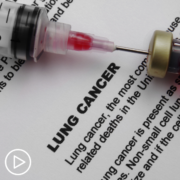
What Urgent Innovations Can Advance Lung Cancer Precision Medicine? |
Transcript:
Lisa Hatfield:
Dr. Cykert, one of the main barriers preventing Black and Latinx patients with lung cancer in rural areas from accessing biomarker testing, and what steps can be taken to address these barriers, including improving awareness, affordability, and availability of testing facilities?
Dr. Samuel Cykert:
Yeah, great, great question. There are several issues here. One is the issue of rural, and the other issue is patients of color who may have barriers of health insurance, barriers of economics, barriers of education, and especially in the case of Latinx folks, barriers of language. So it really is a multiple question, but one thing for sure is we know from past studies that technology diffusion is slow and tends to get out to rural areas later than other areas, and the other problem is treatment volume in rural areas.
So a lot of rural hospitals don’t do bio specimen testing, don’t have the capability of doing that, and so you have this kind of double whammy of low volume testing plus low volume treatment, it’s well-known that surgeons who do more operations, for instance, do better. So given all those factors, I would recommend that rural patients who have presumptive diagnosis of lung cancer, even a suspicion of lung cancer, for instance, a large mass, a greater than 2 centimeter mass on an x-ray or a CT scan, that those patients ask to be referred to the closest high volume center.
I think that’s an important step, and we also have to have close interactions with our rural colleagues so that they’re comfortable of treating aggressively things that are well-treatable in the rural environment and going on to the high-volume centers, the more specialized centers, when things have to be done more aggressively.
When you look at a lot of different healthcare disparities, especially in advanced diseases, a lot of them come from being in areas where technology diffusion hasn’t happened and people don’t have access to the same treatments that they do at higher volume centers. My activation tip here is, for things like biomarker testing and advanced treatments, you need to go to the closest high volume center.
Share Your Feedback
Create your own user feedback survey
Enhancing Lung Cancer Care for Black and Latinx Patients | Tackling Challenges, Implementing Solutions
Enhancing Lung Cancer Care for Black and Latinx Patients | Tackling Challenges, Implementing Solutions from Patient Empowerment Network on Vimeo.
What are challenges and solutions to quality care for Black and Latinx non-small cell lung cancer (NSCLC) patients? Expert Dr. Samuel Cykert from UNC School of Medicine discusses challenges, solutions, and proactive patient advice toward quality care.
[ACT]IVATION TIP
“…for things like biomarker testing and advanced treatments, you need to go to the closest high volume center.”
Download Resource Guide | Descargar guía de recursos
See More from [ACT]IVATED Non-Small Cell Lung Cancer
Related Resources:
Transcript:
Lisa Hatfield:
Dr. Cykert, what specific challenges do Black and Latinx patients with lung cancer often encounter in advocating for themselves within the healthcare system, and how can they navigate these challenges effectively to ensure they receive equitable and quality care?
Dr. Samuel Cykert:
Yes, and in our past research we discovered that there are certain implicit biases and communication biases that affect patients of color, and because of that, I think it’s really important to approach the clinical encounter with cancer care decision-makers with enthusiasm, that meaning making a direct statement that I’m very enthusiastic about getting care for my lung cancer, I’m very enthusiastic about biomarker testing, tailored therapy, surgery and research protocols. So please consider me for all those results, and I know what I said was just a mouthful.
And even if you can remember to just start with, I’m very enthusiastic about getting treatment, and biomarker testing would be good and I’m positive about it, how do you feel about it? Engage the clinician in the conversation so they really know that you’re part of the team and they’re part of the team, and you’re ready to move toward excellent treatment and you’re willing to consider even research stuff.
Share Your Feedback
Create your own user feedback survey
Closing the Gap | Ensuring Equitable Access to Lung Cancer Biomarker Testing
Closing the Gap | Ensuring Equitable Access to Lung Cancer Biomarker Testing from Patient Empowerment Network on Vimeo.
How is biomarker testing implementation going in lung cancer care? Expert Dr. Samuel Cykert from UNC School of Medicine discusses biomarker testing trends, challenges, and proactive advice for patients.
Download Resource Guide | Descargar guía de recursos
See More from [ACT]IVATED Non-Small Cell Lung Cancer
Related Resources:
Transcript:
Lisa Hatfield:
Dr. Cykert, can you provide an overview of the current landscape of biomarker testing implementation in lung cancer care, and highlight any key trends or challenges that you’ve identified in your research or practice?
Dr. Samuel Cykert:
Yes, if you look at the history of innovations in cancer treatment, patients of color, especially Black patients and Native Americans, also always get exposed to the innovation late compared to other patients, and I don’t want that to happen for biomarker testing and treatments, just because some of the results, especially in lung cancer are so, so good. And so what I would say right now is, number one, for advanced cancer, there are already data that show that people of color are falling behind in both initial testing and subsequent testing.
So we really, really have to work on that. But a second thing that’s happening on the innovation front, is there was a study published in the New England Journal of Medicine, just about a year-and-a-half ago, that showed that biomarker testing and treatment could possibly be effective in early curable lung cancer, something called neoadjuvant therapy, where you actually treat patients with the biologic treatment before surgery. In this case, it’s a kind of immunotherapy that works better, it works really all throughout different types of cancer, but with one particular biomarker PD-L1, it works really, really well. And so it’s looking more and more like biological treatments and testing for lung cancer are going to make a big difference.
Lisa Hatfield:
Great, thank you. I do have a quick follow-up question to that too, when I put my patient lens on, so when you talk about the biomarker testing, are all of those biomarkers tested by biopsy or can they be done via blood test, and if a patient didn’t have them done on initial diagnosis, is it possible to have it done after a patient has been diagnosed, if it wasn’t done originally, can they go back and look at that tissue to see if those biomarkers are there?
Dr. Samuel Cykert:
Yes. Right now they’re pretty much all done on tissue specimens, and so it’s important to think about it upfront because obviously you don’t want to go through a biopsy twice if you don’t have to, but it is true that as long as there’s enough tissue taken at the initial biopsy, that preserved tissue can be tested later for other biomarkers that haven’t been done.
Share Your Feedback
Create your own user feedback survey
Empowering Providers to Empower Lung Cancer Patients
Empowering patients is at the heart of efforts at Patient Empowerment Network (PEN), and work toward reducing health disparities is part of conversations among healthcare professionals. Precision medicine and the use of biomarker testing is one area of interest in efforts to eliminate healthcare disparities.
With this in mind, PEN has taken on a new initiative, the Empowering Providers to Empower Patients (EPEP) initiative. Starting in lung cancer, the program expands PEN’s reach to healthcare professionals with the goal of improving physician-patient communication; shared decision-making; and the role that lung cancer patients, survivors, care partners, and healthcare professionals each play in the shared decision-making process.
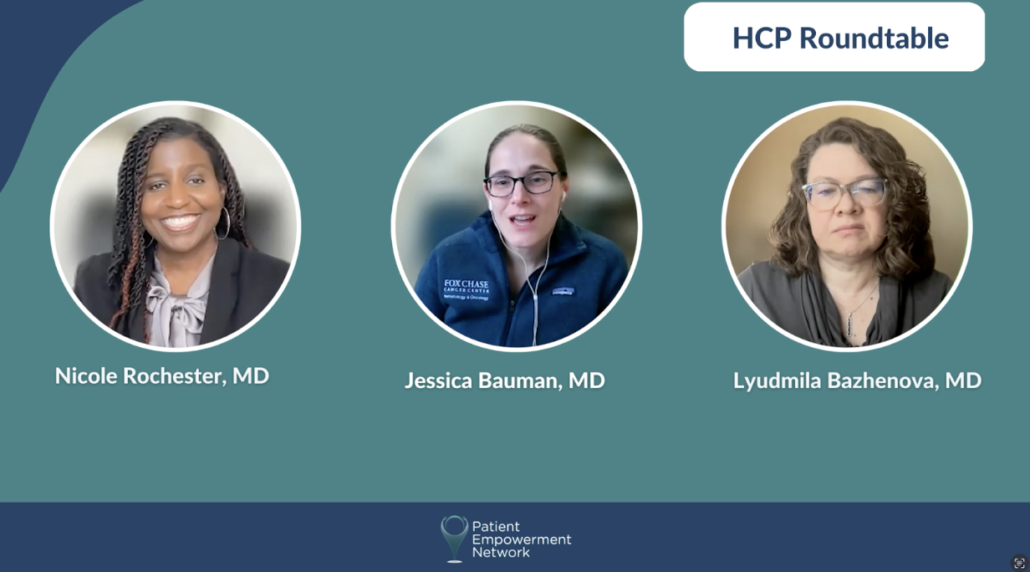
The EPEP initiative includes the following resources:
- Needs Assessment outlines key factors that enable patient empowerment, attributes of an empowered patient, and advice for healthcare professionals to perform a needs assessment for each patient.
- EPEP Roundtables with lung cancer experts Dr. Heather Wakelee, Dr. Lyudmila Bazhenova, Dr. Leigh Boehmer and Dr. Jessica Bauman as they discuss a range of topics including ways to improve physician-patient communication, learnings from tumor boards, collaboration between academic and community oncologists, biomarker testing, and addressing barriers to biomarker testing.
- EPEP Vignettes where lung cancer clinician Dr. Jhanelle Gray from Moffitt Cancer Center shares her experience in biomarker testing, personalized combination therapeutics, and best practices in treating and empowering patients toward more equitable and culturally sensitive care.
- EPEP Biomarker Testing Resource Guide that covers benefits of biomarker testing, when to test, dos and don’ts of biomarker testing, perspectives from a patient and a clinician, and resources for patients.
- EPEP Portal utilizes PEN’s robust resource library and that of numerous trusted advocacy partners to create a vetted list of patient education resources. PEN delivers a curated PDF according to your interests and delivers it efficiently to your inbox.
- Infographics that address the differences between cultural competence versus cultural humility and key steps to work toward practicing cultural humility to help empower your patients in their lung cancer care.
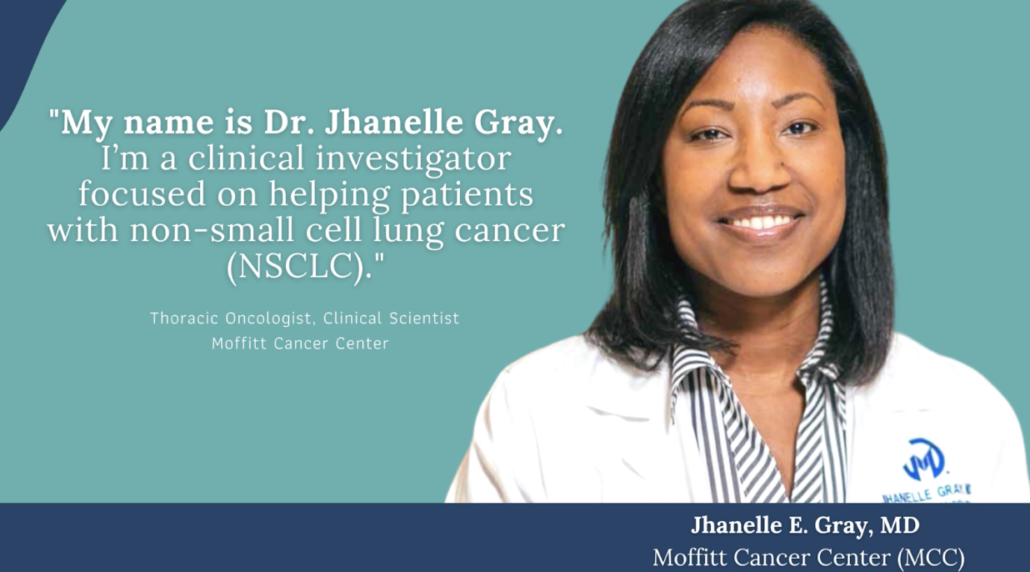
Key Takeaways to Help Empower Lung Cancer Patients
PEN had the opportunity to interview experts Dr. Jhanelle Gray, Dr. Heather Wakelee, and Dr. Leigh Boehmer to learn about some of their expertise. They shared their perspectives about vital ways that they work with patients to help empower them and to work toward the best personalized care for each patient.
Dr. Boehmer shared the importance of biomarker testing to identify driver mutations, “…more than half of patients who’ve developed lung cancer who have never smoked or have a light smoking history are going to have an actionable driving mutation, and even in people who do have a smoking history, of any ethnic background, they’re still 10 to 20 percent or maybe more as we identify more of these driver mutations, where that’s what’s really the force in the tumor.
And if you find it and you can start someone on the appropriate targeted therapy, usually across multiple trials, the toxicity is less than you would get with chemotherapy or immunotherapy…the probability of response is over half, you know, if someone’s going to have a benefit that that’s going to help them feel better for a period of time in controlling their cancer, it really drastically changes their whole tumor outcome, they’re going to be living longer, feeling better, and ultimately that’s our goal when we’re helping someone with metastatic disease…You have to have the physician aware of the importance of finding the mutation, altering the treatment as necessary, and giving that patient the best possible option for care.”
Dr. Gray and Dr. Boehmer also have preferred medical terms when they explain to their patients about biomarker testing. Dr. Gray prefers to steer away from terms that have to do with genomics or genetics and uses the terms “biomarker testing” or “comprehensive biomarker testing” instead. While Dr. Boehmer shares, “I think that’s really important that people always remember to talk about the tumor and not about the mutation in the person, that’s really, really critical.”
Physician Best Practices for Biomarker Testing
With her experience in using biomarker testing in planning personalized combination therapeutics, Dr. Gray shares advice for other healthcare providers. “I think for a provider it is going to be very important when a patient is newly diagnosed with non-small cell lung care especially when they have advanced and later stages as this should be a comprehensive test. This should be a certified assay. I think they should also look at turnaround time for this testing, does the assay include a liquid biopsy portion and a tissue biopsy portion? Is there one that you want to run before the other?
Many times what I will do when I meet a patient initially and they have an advanced or metastatic stage non-small cell lung cancer, I’ll send off the liquid biopsy right then and there, the same day in the hope that I can get the test results back within 7 to 10 days. I will also order the tissue testing. Should the liquid biopsy results from the blood specimen come back sooner, then I can cancel the tissue testing if I feel confident enough in the results. This will then preserve tissue for later analyses. It can also preserve tissue should they need to enroll in an innovative clinical trial and expand their therapeutic options.”
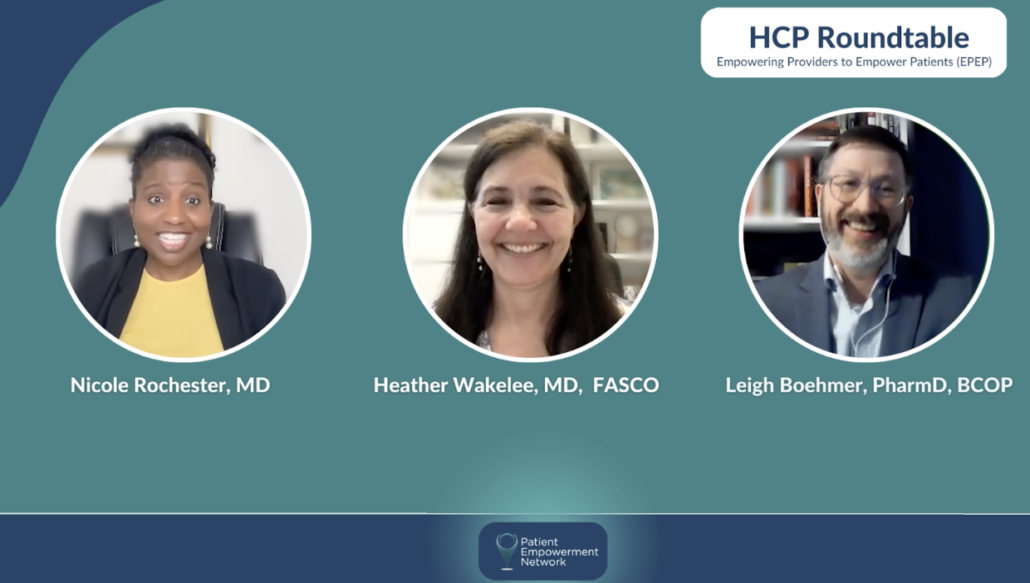
Advocacy for Biomarker Testing
Dr. Wakelee speaks to advocacy for biomarker testing, “…many organizations, including IASLC, including ACCC, including NCCN…I mean, you could name any organization that’s involved in cancer care and education, is really focusing on this issue of making sure that every oncologist knows the importance of doing biomarker testing for patients with non-small cell lung cancer, that we are trying to expand that not just to the oncologist, but also to the folks making the diagnosis, so they can be aware as well…The more people who are aware that’s a standard of care in treating lung cancer, the more that’s going to happen, and then continuing to explore those financial barriers, and as more agents are FDA-approved, where that becomes a preferred first sign option, but you only know that if the testing’s happened, that leads to campaigning to make sure that the testing is being covered as well.”
Dr. Boehmer further explains about the logistics of advocating for biomarker testing. “ACCC…recognizes that a lot of community programs don’t have kind of operational best practices for how to incorporate biomarker testing into a patient’s journey…we’re working on creating care pathways which will help multidisciplinary clinician teams integrate discussions of biomarker testing and its impact at various critical time points along a patient’s diagnosis to treatment, to survivorship or end-of-life care…talking about when and how to have meaningful conversations, and then doing it with health-literate, vetted resources and through a lens of equity and shared decision-making, because you look like me, you had success with it. I’m going to do it for my at-risk patients as well, because one, it’s the right thing to do. And two, you taught me how to do it, and three, you told me what success looks like so I can measure myself against you, and that’s a successful model for scalability.”
And Dr. Gray shares advocacy organizations and ways to move toward biomarker testing equity for all patients. “For those again who are having some difficulty with getting biomarker testing for their patients, I would strongly encourage you to find an advocacy organization such as American Lung Association, LUNGevity, GO2 Foundation, there are many many others out there that are very much interested in improving access to patients with non-small cell lung cancer. This is really a critical area of need and that we really have to drive forward with healthcare equity in this setting…And so, I think putting all this together and coming together as a field is where we can move together and with the patients, the providers, and the advocacy organizations I think that we should all feel empowered to move the needle forward for our patients.”
The bottom line is, while oncologists have more tools to treat lung cancer, access and language remains a big factor in biomarker testing. Comprehensive biomarker testing can play a very important role in the personalized treatment for patients with non-small cell lung cancer (NSCLC), but many questions remain. How do we improve clinician-patient conversations in biomarker testing? And how do we remove barriers that can impede an HCP’s ability to treat patients with personalized care? As the lung cancer field continues to experience tremendous growth in precision medicine, we hope healthcare providers can take advantage of these timely resources of the EPEP initiative to work toward equitable and culturally sensitive care for lung cancer patients.
Becoming an Empowered and [ACT]IVATED Lung Cancer Patient
Patient Empowerment Network (PEN) is committed to helping educate and empower patients and care partners in the lung cancer community. Lung cancer treatment options are ever-expanding with new testing and treatments, and it’s vital for patients and families to educate themselves with health literacy tools and resources on up-to-date information in lung cancer care. With this goal in mind, PEN initiated the [ACT]IVATED Non-Small Cell Lung Cancer program, which targets to inform, empower, and engage patients to stay abreast of the latest in lung cancer care.
The [ACT]IVATED Non-Small Cell Lung Cancer program is geared to newly diagnosed lung cancer patients, yet it is beneficial at any stage of disease. [ACT]IVATED helps patients and care partners stay abreast of the latest options for their lung cancer, provides patient activation tools to help overcome barriers to accessing care and powerful tips for self-advocacy, coping, and living well with cancer.
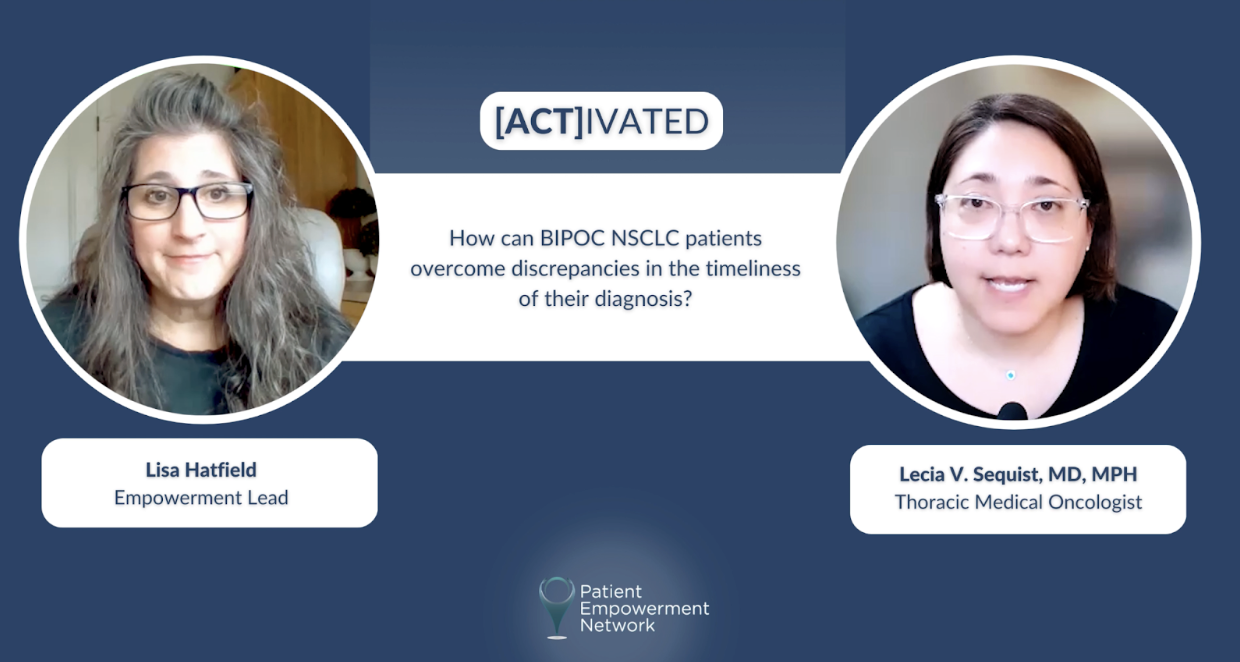
Lung Cancer Stigma and Disparities
Lung cancer is unique in comparison to other types of cancer. Overcoming the lung cancer stigma in the U.S. that was partially created by TV advertising campaigns to quit smoking. Cancer patient Lisa Hatfield spoke with Dr. Lecia Sequist from Massachusetts General Hospital. Dr. Sequist explained lung cancer stigma. “…it all comes together to make people think that those who get diagnosed with lung cancer did something wrong to deserve it, and that’s just not true. Nobody deserves to get cancer of any type. And lung cancer patients do suffer this unique blame that is not necessarily placed on other patients with other types of cancer, it’s really very unique to lung cancer. And it can be harmful for patients in many ways, it can be harmful in interpersonal interactions, but it also leads to policies and the whole way that our care system is set up that disadvantages lung cancer patients compared to other types of cancer patients.”
Though smoking can sometimes lead to lung cancer, this isn’t true for all lung cancer patients. Dr. Lecia Sequist shared some of the data about lung cancer risk and what’s still unknown about lung cancer risk. “…it’s true that cigarette smoking is one risk factor for lung cancer, but it’s not the only one. And we don’t fully understand what all the risk factors might be, but we know that there are people who have smoked a lot in their life and never get lung cancer. And on the flip side, we know that there’s people who have never smoked or who maybe quit 30, 40 years ago and will still get lung cancer. And how do we know who’s at risk?”
Access to lung cancer screening can also vary across the U.S. depending on what state you live in. Dr. Sequist shared about this key difference. “Lung cancer screening is really effective as far as finding cancer in the earliest stages. It’s not equally available across the country. Some of it has to do with there are certain states that expanded their Medicaid coverage as part of the medical care reform…and there are some states that didn’t expand the Medicaid, and then that situation translated into whether lung cancer screening was easy to get started in hospitals in that state. So there are some regions of the country, and a lot of them are in the South as well as the Western U.S., where if you want to get lung cancer screening, you may have to travel more than 30 miles or even more than 50 miles in order to get lung cancer screening.”
Dr. Sequist also shares how BIPOC lung cancer patients or other underrepresented patients can guard against care disparities. “You don’t have to ask permission to get a second opinion, you can just make an appointment with a different oncologist or go to an oncologist if you haven’t seen one before. Because lung cancer is changing and treatments are more successful, and we all have to do more as a community to make sure that those treatments are offered to everyone.”
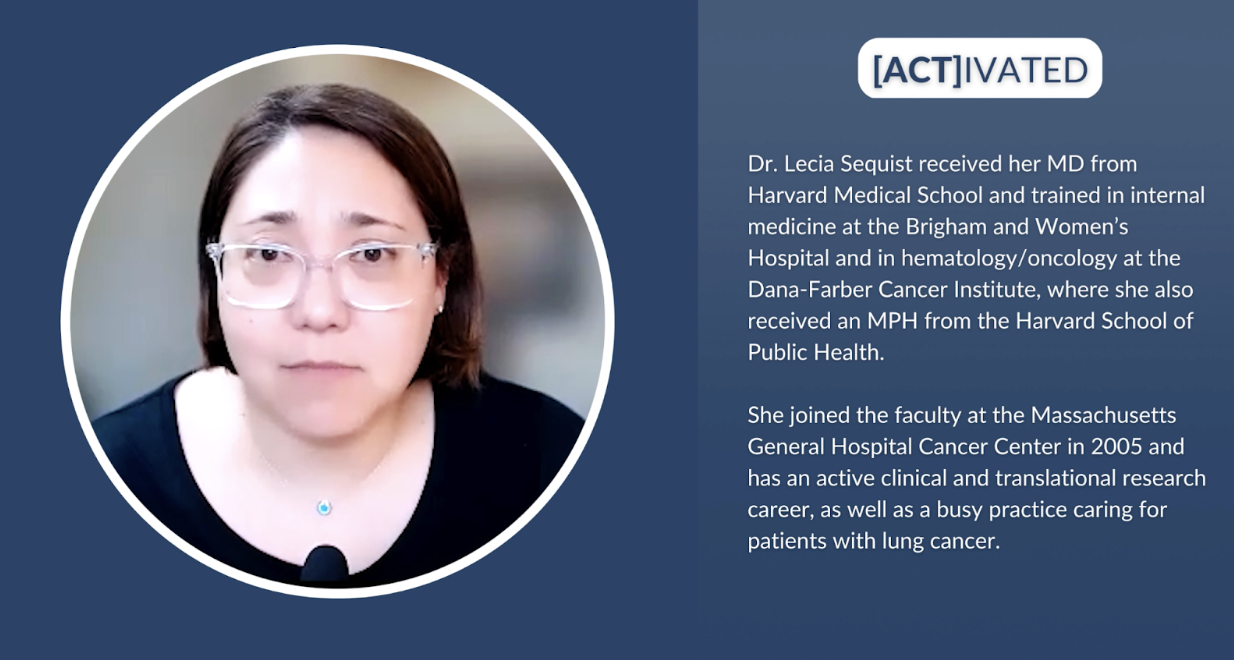
Solutions for Better Lung Cancer Care
Patient education and empowerment are key pieces to receiving informed and optimal care. These efforts can take many forms but include approaches like improving clinical trial access, learning more from credible resources, asking questions to ensure your best care, and helping to educate others about lung cancer.
Dr. Lecia Sequist shared about the importance of learning about lung cancer information from credible resources. “A lot of people get lost in the terminology, the medical terminology. Don’t be afraid to ask questions or go to a website that is recommended, that’s been vetted by doctors to really have good quality information to help you understand what these terms mean. There’s also a lot of misinformation on the websites, that’s why you have to go to a site that maybe your doctor or your patient network recommends to make sure you’re getting accurate information.”
And lung cancer patients and patient advocates can help continue advancements in lung cancer screening and treatments. Dr. Lecia Sequist shared advice for how to take action on behalf of patients.
“Lung cancer can happen if you smoked, if you never smoked, anything in between. Anyone who has lungs can get lung cancer. And we have to take the stigma away from this disease. Nobody deserves to have lung cancer. It’s not something that people cause to happen to themselves, and they certainly shouldn’t be blamed if they are finding themselves in a position where they have lung cancer. So just spreading the word, lung cancer can happen to anyone, anyone with lungs can get lung cancer, I think can help start to change the perceptions.”
The use of artificial intelligence (AI) has led to improvements in lung cancer screening. Dr. Lecia Sequist explained how AI has advanced the detection of lung cancer. “The computer looks at a different type of pattern that human eyes and brains can’t really recognize and has learned the pattern, because we trained the computer with thousands and tens of thousands of scans where we knew this person went on to develop cancer and this one didn’t. And the computer learned the pattern of risk.”
Patient empowerment sometimes means that patients must advocate for their best care, and Dr. Sequist shared advice about testing. “…be sure to ask your doctor if genetic testing has been performed on your cancer, and if not, can it be performed? It’s not always the right answer, depends on the type of cancer that you have and the stage, but if you have adenocarcinoma and an advanced cancer, like stage III or stage IV, it is the standard to get genetic testing and that should be something that can be done.”
[ACT]IVATED Non-Small Cell Lung Cancer Program Resources
The [ACT]IVATED Non-Small Cell Lung Cancer program series takes a three-part approach to inform, empower, and engage both the overall lung cancer community and patient groups who experience health disparities. The series includes the following resources:
- [ACT]IVATED Expert Interviews
- [ACT]IVATED Resources
- [ACT]IVATED Patient Vignettes
- [ACT]IVATED Activity Guides
Though there are lung cancer disparities and disease stigma, patients and care partners can be proactive in gaining knowledge to help ensure optimal care. We hope you can benefit from these valuable resources to aid in your lung cancer care for yourself or for your loved one.
[ACT]IVATION Tip:
By texting EMPOWER to +1-833-213-6657, you can receive personalized support from PENs Empowerment Leads. Whether you’re a lung cancer patient, or caring for someone who is, PEN’s Empowerment Leads will be here for you at every step of your journey. Learn more.
Persistencia frente a la atención médica desdeñosa: El viaje de un paciente
Persistencia frente a la atención médica desdeñosa: El viaje de un paciente from Patient Empowerment Network on Vimeo.
Wanda fue diagnosticada con cáncer de pulmón de células no pequeñas (CPCNP) en la flor de su vida. Se defendió ferozmente incluso después de enfrentar inicialmente una atención médica desdeñosa. Wanda comparte la importancia de “no equiparar una sentencia de muerte con un diagnóstico de cáncer solo porque un miembro de su equipo de atención dice que no le queda mucho tiempo de vida”. Ella comparte valiosas lecciones aprendidas de su viaje por el cáncer de pulmón y la importancia de escuchar su intuición y su cuerpo.
Download Resource Guide | Download Resource Guide en español
See More from [ACT]IVATED NSCLC
Related Resources:
Transcript:
Mi nombre es Wanda y me diagnosticaron cáncer de pulmón de células no pequeñas cuando tenía poco más de 40 años. Soy una mujer negra y, como muchas otras, mi camino hacia el diagnóstico no fue sencillo. Mis síntomas empezaron sintiéndome fatigada y como si fuera a desmayarme. Mi intuición me dijo que algo iba mal y me hice pruebas para diagnosticar el problema. Me detectaron un nódulo en el pulmón, pero el médico no me dio importancia a pesar de que yo conocía bien mi salud y posibles problemas de salud.
Solicité un escáner para investigar más a fondo el nódulo pulmonar, pero mi médico desestimó mi preocupación y no quiso hacerme la prueba. Después de que me hicieran una tomografía por emisión de positrones (PET), el especialista pulmonar que la revisó desestimó mis preocupaciones y decidió hacerme otra en 6 meses. Durante los seis meses siguientes, mis síntomas siguieron empeorando: fatiga, pérdida de peso y sibilancias.Sabía que tenía cáncer de pulmón y me sentía atrapada porque tenía que esperar a la exploración de seguimiento.
Cuando por fin recibí el diagnóstico de adenocarcinoma, sentí una mezcla de alivio por tener razón y rabia porque mi cáncer había empeorado en los últimos 6 meses. Después de dos operaciones para extirparme los ganglios linfáticos y una parte del pulmón, estoy bien y me alegra compartir mi historia para ayudar a otras personas que puedan sentirse descartadas por sus médicos.
Algunas de las cosas que he aprendido en mi lucha contra el cáncer de pulmón son:
- Infórmate y haz preguntas a tus médicos. Infórmese sobre las opciones de tratamiento disponibles y coméntelas con su médico. Los médicos esperan que los pacientes tengan preguntas.
- Pregunte sobre las opciones de ensayos clínicos, si es necesario viajar y si habrá gastos que usted o alguien tendrá que cubrir en su nombre. Pregunte si existen programas que puedan ayudarle con los gastos no cubiertos.
- Siempre es buena idea buscar una segunda opinión. Buscar una segunda opinión no es algo por lo que debas sentirte culpable, y tu vida o la de tu ser querido depende de un diagnóstico preciso.
- Escuche a su intuición y a su cuerpo. Yo sabía que algo iba muy mal, pero mis médicos me ignoraron durante meses antes del diagnóstico.
- Evite a los médicos negativos y no equipare una sentencia de muerte con un diagnóstico de cáncer. Que un miembro de tu equipo médico te diga que no te queda mucho tiempo de vida no significa que esté escrito en piedra.
Estas acciones fueron clave para seguir en mi camino hacia el empoderamiento.
Share Your Feedback:
Create your own user feedback survey
Persistence in the Face of Dismissive Healthcare: One Patient’s Journey
Persistence in the Face of Dismissive Healthcare: One Patient’s Journey from Patient Empowerment Network on Vimeo.
Wanda was diagnosed with non-small cell lung cancer (NSCLC) in the prime of her life. She fiercely advocated for herself even after initially facing dismissive healthcare. Wanda shares the importance of “not equating a death sentence with a cancer diagnosis just because a member of your care team says you don’t have long to live.” She shares valuable lessons learned on her lung cancer journey and the importance of listening to your intuition and body.
Download Resource Guide | Download Resource Guide en español
See More from [ACT]IVATED NSCLC
Related Resources:
Transcript:
My name is Wanda, and I was diagnosed in my early 40s with non-small cell lung cancer. I’m a Black woman, and like many others, my path to diagnosis wasn’t straightforward.
My symptoms began with feeling fatigued and like I might faint. My intuition told me that something was wrong, and I had testing done to help diagnose what the issue might be. A nodule was found in my lung, but I felt dismissed by my doctor even though I was knowledgeable about my health and potential health issues. I requested a scan to further investigate the lung nodule, but my doctor dismissed my concerns and wouldn’t run the test. After I eventually received a PET scan of my lung, the pulmonary specialist who reviewed my scan dismissed my concerns and decided to do another scan in 6 months.
Over the next 6 months, my symptoms continued to worsen with more severe fatigue, weight loss, and wheezing. I knew that I had lung cancer and felt trapped that I had to wait for the follow-up scan. When I finally received my diagnosis of adenocarcinoma, I felt a mixture of relief that I was right and anger that my cancer had worsened over the last 6 months. After two surgeries to remove lymph nodes and a portion of my lung, I’m doing well and am happy to share my story to help others who may feel dismissed by their doctors.
Some of the things I’ve learned on my lung cancer journey include:
- Educate yourself and ask your doctors questions. Learn about the available treatment options and discuss each one with your doctor. Doctors expect patients to have questions.
- Ask about clinical trial options, whether travel is required, and if there will be expenses that you or someone will need to cover on your behalf. Ask if there are programs that can help you with uncovered expenses.
- It’s always a good idea to seek a second opinion. Seeking a second opinion is nothing to feel guilty about, and you or your loved one’s life depends on an accurate diagnosis.
- Listen to your intuition and body. I knew something was seriously wrong but was dismissed by my doctors for months before my diagnosis.
- Avoid negative doctors and don’t equate a death sentence with a cancer diagnosis. Just because a member of your care team says you don’t have long to live doesn’t mean it’s written in stone.
These actions were key for staying on my path to empowerment.
Share Your Feedback:
Create your own user feedback survey
What Steps Can BIPOC Lung Cancer Patients Take to Guard Against Care Disparities?
What Steps Can BIPOC Lung Cancer Patients Take to Guard Against Care Disparities? from Patient Empowerment Network on Vimeo.
How can BIPOC lung cancer patients or other underrepresented patients help guard against care disparities? Expert Dr. Lecia Sequist shares advice for non-small cell lung cancer (NSCLC) patients to help ensure they receive optimal treatment with the most advanced treatments available.
Dr. Sequist is program director of Cancer Early Detection & Diagnostics at Massachusetts General Hospital and also The Landry Family Professor of Medicine at Harvard Medical School.
[ACT]IVATION TIP:
“You don’t have to ask permission to get a second opinion, you can just make an appointment with a different oncologist or go to an oncologist if you haven’t seen one before. Because lung cancer is changing and treatments are more successful, and we all have to do more as a community to make sure that those treatments are offered to everyone.”
Download Resource Guide en español
See More from [ACT]IVATED NSCLC
Related Resources:
Transcript:
Lisa Hatfield:
So, Dr. Sequist, we know that there are significant disparities in the treatment and the outcomes of minority patients who have non-small cell lung cancer. How can patients avoid these discrepancies in the timeliness of their diagnosis, because that can be an important factor in their outcome?
Dr. Lecia Sequist:
Yeah. I think lung cancer has changed a lot, but in the last 10 years, and there are better treatments than there used to be, and there’s a lot more treatments than there used to be, but not all doctors are aware of these new developments. And I think some doctors still have a kind of an old-fashioned nihilistic view about lung cancer, which can be very negative, which is that lung cancer can’t be treated effectively and patients are just going to do very poorly. That’s not true anymore. It may have been true 20, 30 years ago, unfortunately. But with treatments today, lung cancer patients can live longer, be cured more often and have better quality of life than with some of the older treatments.
And I think in the ideal world, the responsibility really should be on the physicians to make sure that they’re offering those treatments to patients, but in the real world, that doesn’t always happen. And so I think something that patients can do to empower themselves is also to ask their physicians if there’s anything else that can be done or if they should see a second opinion. If you’re feeling like your doctor is not offering you really many options or is being kind of nihilistic, having a very negative picture of what might happen to you with your cancer, then I would just get a second opinion. You don’t have to ask permission to get a second opinion, you can just make an appointment with a different oncologist or go to an oncologist if you haven’t seen one before. Because lung cancer is changing and treatments are more successful, and we all have to do more as a community to make sure that those treatments are offered to everyone. But until that day comes, I think patients also need to feel empowered to ask for other treatments and other opinions.
Share Your Feedback:
Create your own user feedback survey
Can Artificial Intelligence and Machine Learning Help Advance Screening for Lung Cancer?
Can Artificial Intelligence and Machine Learning Help Advance Screening for Lung Cancer? from Patient Empowerment Network on Vimeo.
How will lung cancer personalized medicine be improved with advanced technologies? Expert Dr. Lecia Sequist explains how artificial intelligence and machine learning help advance screening for lung cancer and shares advice for patients.
Dr. Sequist is program director of Cancer Early Detection & Diagnostics at Massachusetts General Hospital and also The Landry Family Professor of Medicine at Harvard Medical School.
[ACT]IVATION TIP:
“… if you are 50 and you have smoked in the past, I would urge you to talk to your doctor about whether you can access lung cancer screening. But if you’re younger or you haven’t smoked in the past, you can’t access lung cancer screening right now. And we’re hoping to change that with AI that can really help figure out who is at risk of this disease.”
Download Resource Guide en español
See More from [ACT]IVATED NSCLC
Related Resources:

How Do You Break Down Lung Cancer Diagnosis to New Patients? |
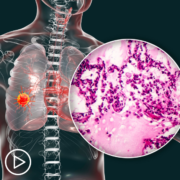
Exciting Lung Cancer Data and Studies: A Look At Neoadjuvant Treatment |

What Are the Noted Disparities in Lung Cancer Screening and Access |
Transcript:
Lisa Hatfield:
Dr. Sequist, technology is advancing at such a fast pace, and we’re hearing words like artificial intelligence and machine learning. And I just read an article about a team that you’ve been working with that is developing or has developed an AI model that can detect future lung cancer risk. I believe it’s based on CT scans. Can you speak to that a little bit more and also talk a little bit more about where you see this AI technology taking cancer research and predicting cancer and also any challenges that we might face with AI and machine learning in healthcare?
Dr. Lecia Sequist:
Yeah. AI seems to be everywhere. You turn on the news or you look at your phone, and it’s talking about AI. And some of it seems scary, and Hollywood doesn’t help because there’s lots of movies about computers or robots kind of taking over the human race. And I think we have to separate Hollywood from real life. Artificial intelligence or machine learning, it’s a very general term. It can mean a lot of different things depending on what the context is. But it’s basically just a tool for understanding patterns. And we all understand patterns in our own life or our own house. I personally know that my dog is going to want to, as soon as we wake up in the morning, is going to want to go outside and then is going to want to have some food, and there are different patterns that you know in your daily life that you recognize, and you can anticipate what’s going to happen next.
AI is a tool that helps us anticipate what’s going to happen next for patterns that are way more complex than, yeah, your dog’s going to want to go outside and eat some food. So computers can sometimes pick up patterns that the human brain can’t really pick up, because they’re just too complicated. And that’s what we’ve found in our research. One of the vaccine things about lung cancer and trying to figure out how we can prevent lung cancer or find it at the earliest stage when it’s most curable is that it’s very hard to know who’s at risk. We know that lung cancer is one of the most common cancers out there, but knowing who is truly at risk and separating one person from the next is not so simple.
In the past, it’s mainly been, you know, determined by whether or not you ever smoke cigarettes. And it’s true that cigarette smoking is one risk factor for lung cancer, but it’s not the only one. And we don’t fully understand what all the risk factors might be, but we know that there are people who have smoked a lot in their life and never get lung cancer. And on the flip side, we know that there’s people who have never smoked or who maybe quit 30, 40 years ago and will still get lung cancer. And how do we know who’s at risk? That’s what we tried to solve with our research that I worked on with my colleagues at Mass General Hospital where I work and also at MIT, Massachusetts Institute of Technology, which is just down the road from us. And so we brought together our medical knowledge and our computer knowledge and tried to come up with a way to predict for any given individual person, are they at risk for lung cancer.
By looking at their lungs and not looking at the lungs the way a human radiologist sort of says, okay, there’s the right lung, there’s the left lung, and they’re looking for things that already exist like a tumor or a mass. The computer looks at a different type of pattern that human eyes and brains can’t really recognize and has learned the pattern, because we trained the computer with thousands and tens of thousands of scans where we knew this person went on to develop cancer and this one didn’t. And the computer learned the pattern of risk. And so using an X-ray or a CAT scan to predict future risk is something a little different. In medicine, we usually use an X-ray to say, okay, what’s happening now? Why does this patient have a fever? Why is this patient bleeding? And using an X-ray or a CAT scan in this case to predict the future is kind of a new thought for doctors. But we think that it could be a really valuable tool to help us understand who’s at risk for many different kinds of diseases. We happen to look at lung cancer, but I think you could use this idea for other diseases too.
Lisa Hatfield:
So will this AI model become mainstream anytime soon if a patient wants to access that? Or is it only being used for research purposes?
Dr. Lecia Sequist:
Well, we do before we start to offer anything mainstream or as part of routine care, we really need to understand how it can be used to help patients. So we are running some clinical trials right now to try and understand, is this a tool that could be used, for example, to give someone access to lung cancer screening? Because right now, if you want to have lung cancer screening, which is a very effective screening test to try and find cancer in people who feel completely well, trying to find cancer at the earliest stage before it has spread, can we give people access to lung cancer screening by using this AI test? Right now and if you want to get lung cancer screening, you have to be 50 or older, and you have to have smoked in the past. And if that fits your, if you are 50 and you have smoked in the past, I would urge you to talk to your doctor about whether you can access lung cancer screening. But if you’re younger or you haven’t smoked in the past, you can’t access lung cancer screening right now. And we’re hoping to change that with AI that can really help figure out who is at risk of this disease.
Lisa Hatfield:
Thank you. I’m excited to see where this goes in the future.
Share Your Feedback:
Create your own user feedback survey

